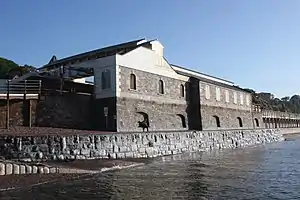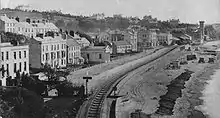Dawlish | |
|---|---|
 Dawlish station seen from the beach in 2018, before the sea wall was raised to platform level | |
| General information | |
| Location | Dawlish, Teignbridge, Devon England |
| Coordinates | 50°34′50″N 3°27′52″W / 50.5805°N 3.4645°W |
| Grid reference | SX964766 |
| Managed by | Great Western Railway |
| Platforms | 2 |
| Other information | |
| Station code | DWL |
| Classification | DfT category D |
| History | |
| Original company | South Devon Railway |
| Pre-grouping | Great Western Railway |
| Post-grouping | Great Western Railway |
| Key dates | |
| Opened | 1846 |
| Rebuilt | 1875 |
| Passengers | |
| 2018/19 | |
| 2019/20 | |
| 2020/21 | |
| 2021/22 | |
| 2022/23 | |
Listed Building – Grade II | |
| Feature | Dawlish railway station |
| Designated | 17 July 1951 |
| Reference no. | 1096669[1] |
| Notes | |
Passenger statistics from the Office of Rail and Road | |
Dawlish railway station is on the Exeter to Plymouth line and serves the seaside resort town of Dawlish in Devon, England. It is located 206 miles 7 chains (331.7 km) from London Paddington, via Box.[2]
The station is built on the sea wall, as is the railway line, and has often suffered from storm damage due its proximity to the sea. South of the station, the railway passes through five tunnels in the cliffs as it follows the coastline.
History

The station was opened by the South Devon Railway on 30 May 1846.[3] The wall with bricked up windows that can be seen in the car park is the remains of the engine house that used to power the trains while they were worked by atmospheric power from 13 September 1847 until 9 September 1848. At this time it was one of Isambard Kingdom Brunel's 7 ft (2,134 mm) broad gauge railways.
The station initially had just one platform on the landward side with a loop line closer to the sea, but a second platform was added to serve the loop line on 1 May 1858. The original wooden station and train shed was burnt down on 14 August 1873.[4] The South Devon Railway built a new station with the platforms connected by an iron bridge, roofed with glass. The principal buildings were constructed adjoining Station Road, and the booking office was fitted with pitch pine cornice and fittings. Star gas pendent lights were installed, and a lift for taking up luggage to the platform levels. The first-class waiting rooms were furnished with Brussels carpets and polished oak furniture. The contractor was Blatchford and Son of Tavistock and the cost was £4,000 (equivalent to £400,000 in 2021).[5] The new station was opened on 12 April 1875.[6]
An unusual feature of the section of line running towards Teignmouth was the sudden 'dip' in the track that once existed, resulting from the demand by a local resident who did not wish to lose his view of the sea.[7]
The South Devon Railway was amalgamated into the Great Western Railway on 1 February 1876, and on 20 May 1892 the line was converted to 4 ft 8+1⁄2 in (1,435 mm) standard gauge. The Great Western in turn was nationalised into British Railways on 1 January 1948.
The platforms have been extended several times to cope with the crowds and now nearly reach Coastguards' Footbridge, although the Exeter platform was shortened again in 1970.[8] The decorative iron and glass canopies above the platforms were replaced by concrete beams and glass panels in 1961 but the glass has since been replaced by Perspex.[9] Goods traffic was withdrawn on 17 May 1965.
After a major storm in 2014 washed out the track bed and made an 80-metre (260 ft) breach in the sea wall north of the station, plans were developed to reinforce and replace the sea wall around the station area. This work, which was expected to cost £80 million, started in 2020[10] and was largely completed in late summer 2022. During this time the sea wall walkway was raised to platform level and both platforms were resurfaced. The platform lighting was improved and an accessible lift will be constructed following completion of the sea wall works to replace the rail-level crossing.[11][12]
Signal boxes
%252C_13-5-87._-_geograph.org.uk_-_1710632.jpg.webp)
The first signal box was provided on the seaward platform beside the north end of the waiting room but this was replaced by a new two-storey signal box on 9 September 1920 on the opposite platform. So as to fit on the narrow platform the brick-built lower storey which contained the interlocking equipment was narrower than usual, with the upper storey was vaulted out from this to give a full size operating floor.[8]
After the summer of 1970 the signal box was only opened on summer weekends or if there were problems working along the sea wall. It finally closed on 27 September 1986 since when the trains have been controlled from Exeter.[8] Despite attempts to find a commercial use for the redundant building, it remained empty until 2013 when it was demolished during the period 2–5 July.[13]
1921 accident
On 22 September 1921 a Plymouth to Crewe passenger train collided with an Exeter St Davids to Newton Abbot goods train that was shunting in the station. The passenger train, hauled by Star Class 4055 Princess Sophia, failed to stop at a danger signal. Cranes cleared the line by lifting damaged wagons onto the beach, where they remained for a couple of days.[8]
Station masters
- Francis Farr Fowler 1859 - 1862[14]
- Mr. Endle 1862 - 1863
- Mr. Quigley 1863 - 1864
- Joseph Pearse 1864 - 1866[15][note 1]
- Mr. Mills ???? - 1869[16]
- George E. Bray 1869 - 1878[17]
- Henry Ewart Williams 1879 - 1889[18][note 2]
- Stephen A. Hunt 1889 - 1895[note 3]
- W. A. Harrison 1895 - 1896[note 4]
- Richard D. Pressick 1896 -1909[19][note 5]
- Harry Jennings Gibson 1909 - 1927[20]
- W. A. Price 1927 - 1935[21][note 6]
- H. J. Vowles 1935 - ???? (formerly station master at Bovey Tracey)[22]
- G. Mitchell ca. 1949
Location

The station is adjacent to the beach near the gardens at the centre of the town. The main frontage is in banded rusticated masonry. The remaining walls are rendered except for the east elevation, which faces the sea, which is in rubble stone.The station buildings are Grade II listed.[1] It has two storeys as the railway runs above street level and a café occupies most of the street frontage.[9] The main entrance is at road level on the side served by trains to Exeter. This opens onto a booking office with an ornate ceiling[8] from where a flight of stairs lead up to the Exeter platform, but step-free access can be obtained through a gate from the car park beside the station buildings, which is the only access route when the booking office is closed.
Access to the opposite platform is by way of a covered footbridge, the stairways of which are contained within the building. Passengers who cannot use the steps can be escorted across the barrow crossing at the south end of the station by the station staff.
Immediately to the south of the station is the low Colonnade Viaduct, which carries the railway above the small river that runs through the gardens and the main footpath from the town to the beach and the South West Coast Path. To the north of the station is Coastguards Footbridge, with Coastguards Cottage, now a café, on the hill above the line to the west, and Brunel's Boat House between the line and the beach to the east.
Services

The revised timetable from 15 December 2019 has two or three Great Western Railway trains per hour calling at Dawlish in each direction. Most trains run between Exmouth and Paignton although some start or finish at Exeter St Davids. On Sundays the service is less frequent and most trains only run between Exeter St Davids and Paignton.[23] The line from Exeter St Davids through Dawlish to Paignton is marketed as the "Riviera Line".
A few longer-distance Great Western Railway trains from Bristol Temple Meads, Cardiff Central or from London Paddington also call at Dawlish as do a few CrossCountry services from the Midlands, North of England and Scotland.[23] Most of these services, including the Torbay Express from Paddington, continue to Paignton but some instead run to Plymouth and even Penzance. At other times passengers travelling east or north catch a local train and change into main line trains at Exeter St Davids, or at Newton Abbot if travelling westwards.
| Preceding station | Following station | |||
|---|---|---|---|---|
| Dawlish Warren | Great Western Railway Riviera Line |
Teignmouth | ||
| Exeter St Davids | CrossCountry Cornwall-Scotland |
Teignmouth | ||
Cultural References
Simon Jenkins included in his 2017 book of the best 100 stations in Britain.[24]
Notes
- ↑ Pearse was formerly station master of Torre station, afterwards station master at Teignmouth.
- ↑ Williams was afterwards station master at Chippenham.
- ↑ Hunt was afterwards station master at West Drayton.
- ↑ Harrison was formerly station master at West Drayton.
- ↑ Pressick was formerly station master at Lostwithiel.
- ↑ Price was afterwards stationmaster at Teignmouth.
References
- 1 2 Historic England. "Dawlish Railway Station (1096669)". National Heritage List for England. Retrieved 20 July 2016.
- ↑ Padgett, David (June 2018) [1989]. Munsey, Myles (ed.). Railway Track Diagrams 3: Western & Wales (6th ed.). Frome: Trackmaps. map 8B. ISBN 978-1-9996271-0-2.
- ↑ Gregory, R.H. (1982). The South Devon Railway. Salisbury: Oakwood Press. ISBN 0-85361-286-2.
- ↑ "Burning of Dawlish Railway Station". West Briton and Cornwall Advertiser. England. 21 August 1873. Retrieved 19 February 2017 – via British Newspaper Archive.
- ↑ UK Retail Price Index inflation figures are based on data from Clark, Gregory (2017). "The Annual RPI and Average Earnings for Britain, 1209 to Present (New Series)". MeasuringWorth. Retrieved 11 June 2022.
- ↑ "Dawlish Railway Station". Western Morning News. England. 13 April 1875. Retrieved 19 February 2017 – via British Newspaper Archive.
- ↑ Awdry, Christopher (1992). Brunel's Broad Gauge Railway. Sparkford: Oxford Publishing Co. ISBN 978-0-860935-04-9.
- 1 2 3 4 5 Kay, Peter (1991). Exeter - Newton Abbot: A Railway History. Sheffield: Platform 5 Publishing. ISBN 1-872524-42-7.
- 1 2 Oakley, Mike (2007). Devon Railway Stations. Wimbourne: The Dovecote Press. ISBN 978-1-904349-55-6.
- ↑ "Dawlish Sea Wall". Network Rail. Retrieved 13 August 2022.
- ↑ "Dawlish sea wall – section two". Network Rail. Retrieved 13 August 2022.
- ↑ "Sea Wall rebuilding archives". Dawlish Beachcams. Retrieved 13 August 2022.
- ↑ Marsden, Colin J. (September 2013). "Dawlish signal box goes". Modern Railways. Key Publishing. 70 (780): 16. ISSN 0026-8356.
- ↑ "Dawlish". Western Daily Mercury. England. 27 May 1862. Retrieved 23 September 2017 – via British Newspaper Archive.
- ↑ "Mr. Pearse". Exeter and Plymouth Gazette. England. 5 January 1866. Retrieved 23 September 2017 – via British Newspaper Archive.
- ↑ "Mr. Mills". Western Morning News. England. 8 January 1869. Retrieved 23 September 2017 – via British Newspaper Archive.
- ↑ "Dawlish". Exeter and Plymouth Gazette. England. 8 February 1878. Retrieved 23 September 2017 – via British Newspaper Archive.
- ↑ "Dawlish. The Stationmaster". Exeter Flying Post. England. 24 May 1889. Retrieved 23 September 2017 – via British Newspaper Archive.
- ↑ "Dawlish". Western Times. England. 22 October 1909. Retrieved 23 September 2017 – via British Newspaper Archive.
- ↑ "Death of former Dawlish Stationmaster". Exeter and Plymouth Gazette. England. 12 January 1940. Retrieved 23 September 2017 – via British Newspaper Archive.
- ↑ "Stationmaster moves from Dawlish to Teignmouth". Exeter and Plymouth Gazette. England. 29 November 1935. Retrieved 23 September 2017 – via British Newspaper Archive.
- ↑ "Great Western Railway Staff Changes". Exeter and Plymouth Gazette. England. 13 December 1935. Retrieved 4 July 2021 – via British Newspaper Archive.
- 1 2 "D1 train times" (PDF). Great Western Railway. Archived from the original (PDF) on 9 December 2019. Retrieved 9 December 2019.
- ↑ Jenkins, Simon (October 2017). "10 of the best railway stations in Britain". The Guardian.
Further reading
- Beck, Keith; Copsey, John (1990). The Great Western in South Devon. Didcot: Wild Swan Publication. ISBN 0-906867-90-8.
- Cooke, RA (1984). Track Layout Diagrams of the GWR and BR WR, Section 14: South Devon. Harwell: RA Cooke.
| This station offers access to the South West Coast Path | |
|---|---|
| Distance to path | 50 yards (46 m) |
| Next station anticlockwise | Dawlish Warren 1.75 miles (2.82 km) |
| Next station clockwise | Teignmouth 3 miles (4.8 km) |